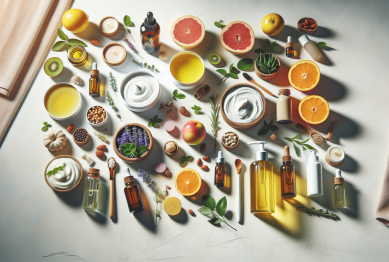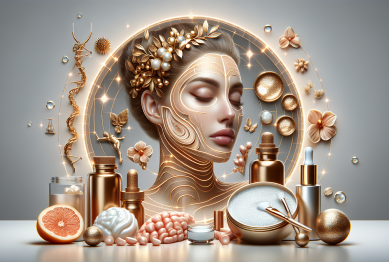Unlock the science and habits that help many people achieve radiant, healthy skin. This comprehensive guide explains evidence-backed routines, ingredient tips, and lifestyle choices that encourage a luminous complexion for different skin types and all ages.
The Building Blocks of Radiant Skin
Glowing skin is not just a result of luck or expensive treatments. It starts with understanding the biology of your skin and providing it with the right support. Skin glow is directly linked to hydration, proper skincare routines, and key nutrients. For instance, a healthy barrier helps retain moisture and guards against environmental damage. Regular cleansing, balanced moisturizers, and consistent use of sun protection set a strong foundation for any skin type. Science suggests that simple habits like gentle washing and daily broad-spectrum sunscreen are among the most protective, no matter your age or genetics. These steps lay the groundwork for a complexion that appears naturally vibrant and even-toned.
Hydration is often underrated, but it’s crucial for maintaining plump, supple skin texture. Using products with humectants such as hyaluronic acid or glycerin can help draw water into the skin, increasing its resilience and radiance. Drinking enough water throughout the day complements topical hydration. In many cases, integrating a humidifier or fixing environmental dryness at home also supports a dewy look. Balanced skin frequently looks brighter because its protective barrier is intact, allowing for a deeper, healthy glow that comes from within. People pursuing glowing skin should look for gentle products that replenish and repair rather than strip skin of its natural oils.
Nutritional choices play a silent but powerful role in how skin appears. Antioxidants from fruits and vegetables repair oxidative stress that can decrease skin luminosity. Vitamin C, both applied topically and consumed through foods, assists with collagen production—a vital structure that keeps skin looking plump and smooth. Omega-3 fatty acids, often found in fish or plant oils, help sustain the skin barrier and fight inflammation. Layering these evidence-based habits with mindful stress management can have a synergistic effect over time, elevating skin’s natural glow and resilience.
Everyday Habits That Impact Skin Radiance
Daily routines strongly shape how luminous the skin looks. Many find that consistent sleep patterns, regular movement, and mindful breathing contribute to skin renewal. Sleep, for example, is when most cellular repair occurs. Skimping on restorative rest may lead to dullness, dark circles, or uneven skin tone. Creating a nightly ritual with gentle cleansing and simple hydration can signal the body to repair itself. Exercise helps circulation, providing more oxygen and nutrients to surface layers—the building blocks of radiant, glowing skin. Even light physical activity, like walking or yoga, is associated with improved overall complexion.
Sun exposure impacts skin radiance more than many expect. While a healthy glow may look like a tan, research consistently shows that unprotected sun exposure hastens aging and compromises evenness of tone. Using broad-spectrum sunscreen daily, wearing hats, and seeking shade when possible are proven to limit sun damage and preserve the dewy look. Products with antioxidants can amplify sun defense, especially when paired with healthy skin hydration and recovery products at night. In the long term, these habits contribute to more youthful, glowing skin for years to come.
Stress and emotional wellness also influence skin’s radiance significantly. Chronic stress can drive inflammation, trigger breakouts, and contribute to loss of luster. Mindfulness practices such as meditation or breathwork have been linked to a calmer complexion and more resilient skin barrier. Many experts recommend cultivating enjoyable self-care routines—like short evening massages with botanical oils or five minutes of relaxation before sleep—to help the skin reflect inner balance. These lifestyle tweaks, while simple, often yield visible improvements in skin texture and glow over time.
Choosing Ingredients That Promote Glow
The skincare market offers a vast range of ingredients touted for luminous skin. Selecting substances backed by credible science is important to maximizing results. Niacinamide, for instance, is celebrated for enhancing barrier strength and reducing redness and blotchiness. Vitamin C, lauded for brightening, is a proven antioxidant that helps reduce the look of dullness and discoloration. Retinoids, derived from vitamin A, encourage gentle resurfacing and boost cell turnover—two critical factors for glowing skin. Layering these powerful ingredients gradually, as recommended by dermatologists, supports visible improvement without overwhelming the skin.
Hydrating ingredients play a different but equally crucial role. Humectants such as glycerin and hyaluronic acid are instrumental in drawing moisture into the skin, giving it a healthy bounciness and sheen. Ceramides and fatty acids naturally found in the skin barrier can be replenished with topicals, helping lock in moisture and defend against irritation. These ingredients build the base for improved clarity and reflectivity, allowing light to bounce more evenly off the skin surface—creating the sought-after “glow.” Balanced formulas that combine antioxidants and hydrators work especially well for those looking to simplify routines without sacrificing results.
Not all skincare actives have universal benefits; some may cause side effects if misused. Stronger treatments, like chemical exfoliants or high-dose retinoids, require careful introduction and supervision, especially for sensitive skin. Patch testing can help minimize risk of irritation. Those interested in botanical extracts—like green tea or licorice root—will find these play supportive roles by calming redness and providing additional antioxidants. Consulting with reputable sources or a dermatology professional can ensure the chosen products nurture individual skin needs and support consistent radiance over time.
Addressing Common Glow Challenges
Many people experience periods when skin looks less vibrant. Factors like hormonal changes, climate shifts, and dietary habits can influence glow. Seasonal transitions may introduce dryness or excess oil, both of which can affect skin’s luminosity. Switching to richer creams in winter or lightweight hydrators in summer can help maintain balance. Paying attention to these shifts allows for small adjustments that preserve skin’s natural radiance in differing conditions. Those facing persistent challenges should investigate potential underlying factors like allergies or sensitivities that may be disrupting skin clarity.
Dullness and texture irregularities are frequent concerns, especially with age. Regular, gentle exfoliation—either with soft scrubs or chemical exfoliants—encourages the removal of dead surface cells, revealing fresher and more radiant skin beneath. It’s essential not to overdo exfoliation, as this can damage the delicate barrier and cause redness or increased dryness. Using a mild exfoliant once or twice a week is often sufficient for most. Those who focus on consistency, rather than intensity, often report noticeable improvements in skin glow over several weeks or months.
Navigating specific issues like uneven tone, hyperpigmentation, or occasional breakouts requires a tailored approach. Targeted treatments with niacinamide, vitamin C, or azelaic acid support brightness and evenness while being gentle for ongoing use. Redness-prone skin may benefit from calming formulas with allantoin or panthenol. For acne-prone skin, integrating non-comedogenic, soothing hydrators can maintain glow without clogging pores. Monitoring how skin responds to each addition and modifying routines according to seasonal or lifestyle changes builds resilience and keeps the skin looking luminous despite common challenges.
Diet, Mindfulness, and Holistic Glow Practices
Holistic wellness practices can amplify skin glow from within. A varied diet rich in colorful produce, whole grains, omega-3s, and lean proteins supports skin repair and resilience. Antioxidant-rich foods such as berries, spinach, and nuts help fight free radicals that contribute to dullness. Drinking adequate water, while not a direct miracle cure, aids in overall cell function and can help achieve softer, more radiant skin. Prioritizing anti-inflammatory foods may also calm chronic redness or sensitivity, supporting glow in those with reactive skin types.
Stress management directly influences skin health. Mindfulness activities—including meditation, yoga, or simple breathwork—have been associated with lower levels of cortisol, a stress hormone linked to flare-ups and less luminous skin. Setting aside moments for self-care can translate into a healthier complexion over time. This can be as simple as a short massage with nourishing oils, practicing gratitude, or engaging in quiet activities that recharge mental well-being. Such habits have ripple effects on immune function and may indirectly support long-term skin glow.
Sustainable practices often outperform quick fixes. Establishing regular sleep routines, spending time in nature, and limiting exposure to major skin disruptors (like pollution or harsh chemicals) collectively enhance the skin’s ability to reflect light and appear radiant. Many experts recommend focusing on pleasure and consistency in both diet and personal care routines for achievable, long-lasting glow. Over time, these mindful choices accumulate, providing an authentic and sustained luminosity that comes from total wellness—not just what’s applied to the skin.
References
1. American Academy of Dermatology Association. (2023). Skin care: Tips for healthy skin. Retrieved from https://www.aad.org/public/everyday-care/skin-care-basics/care/skin-care-tips
2. Harvard Health Publishing. (2023). The science of skin care. Retrieved from https://www.health.harvard.edu/womens-health/the-science-of-skin-care
3. Mayo Clinic. (2023). Healthy skin: The basics. Retrieved from https://www.mayoclinic.org/healthy-lifestyle/adult-health/in-depth/skin-care/art-20048237
4. Cleveland Clinic. (2023). What makes skin glow? Retrieved from https://health.clevelandclinic.org/what-makes-skin-glow
5. National Institutes of Health. (2021). Nutrition and skin health. Retrieved from https://www.niams.nih.gov/health-topics/skin-health
6. Mindful.org. (2023). Can mindfulness improve your skin? Retrieved from https://www.mindful.org/can-mindfulness-improve-your-skin/









